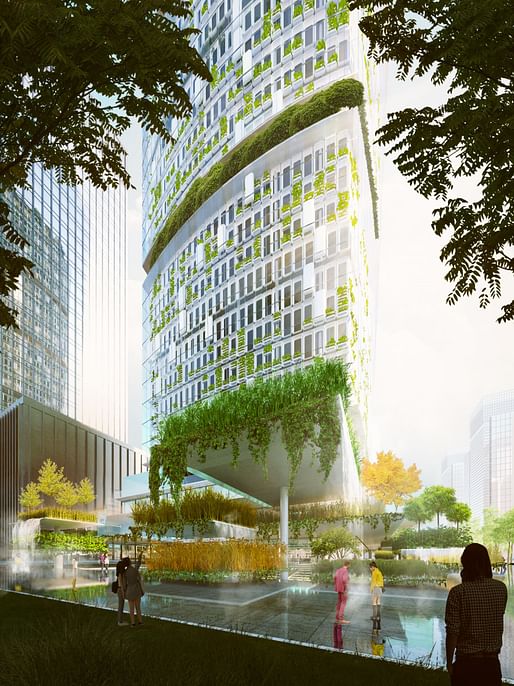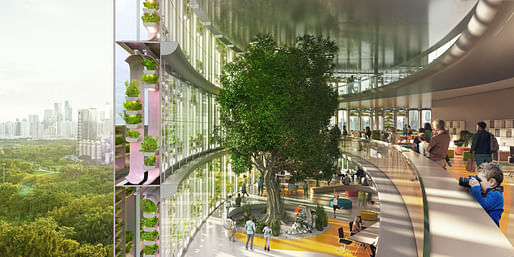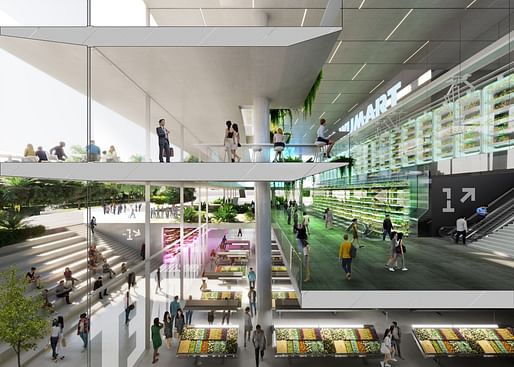
Carlo Ratti Associati (CRA) has unveiled a project dubbed “the world’s first farmscraper,” to be built in Shenzhen, China. The 218-meter-high, 51-story Jian Mu Tower will contain a large-scale farm system with the ability to produce crops to feed 40,000 people per year, as well as offices, a supermarket, and a food court.
CRA’s design was among the finalists for an international competition organized by leading Chinese supermarket chain Wumart, occupying the last available plot of land in Shenzhen’s Central Business District. The name of the Jian Mu Tower is derived from the mythical symbol of the “jian mu tree” which, in ancient Chinese folklore, connects heaven and earth. According to the tradition, heaven is depicted as round, while the earth is square; aspects which are echoed in the building’s form through a rectangular base gradually morphing into a tubular form as it rises.

The scheme’s façade consists of a 10,000-square-meter vertical hydroponic farm extending the entire height of the building, estimated to produce 270,000 kilograms of food per year. The Jian Mu Tower seeks to “establish a self-sustained food supply chain” where the cultivation, harvest, sale, and consumption of food takes place under one roof.

For the system’s development, CRA worked with Italian agriculture innovators ZERO, creating a final design that allows for the production of salad greens, fruits, and herbs. An AI-supported “virtual agronomist” will oversee the farm’s day-to-day operations, including managing irrigation and nutritional conditions. On the building’s exterior, meanwhile, a series of landscaped terraces contain a variety of flora including water lily, fern, and lychee, aimed at promoting biodiversity. Internally, a series of inner gardens are contained in double-height volumes, seeking to promote social interaction and wellbeing among office users. The prominence of greenery on the building’s surface is also designed to reduce solar gain internally, reducing the need for air conditioning.

“Small-scale urban farming is happening in cities all over the world — from Paris to New York to Singapore,” says Carlo Ratti, founding partner of CRA and professor at the Massachusetts Institute of Technology. “Jian Mu Tower, however, takes it to the next level. Such approach has the potential to play a major role in the design of future cities, as it engages one of today’s most pressing architectural challenges: How to integrate the natural world into building design. In addition to producing food, the Jian Mu Tower’s farm helps with solar shading — a key issue in tall buildings.”

The scheme is the latest in a series of prominent commissions in Shenzhen led by international architects. In May, MVRDV’s sustainably-minded, mixed-use Shenzhen Terraces began construction, SANAA unveiled images of their Shenzhen Maritime Museum, and Grimshaw unveiled their mango tree-inspired design for Shenzhen’s international airport and transport hub. Last month, both Snøhetta and Sou Fujimoto Architects unveiled their competition proposals for a landmark along Shenzhen’s waterfront.
Earlier this month, meanwhile, CRA unveiled plans for a new museum dedicated to carbon fiber technology in Piacenza, Italy. Ratti’s MIT Senseable City Lab has also recently unveiled its Favelas 4D project, seeking to create digital replicas of Brazil’s favelas.
21 Comments
For sunshine, I imagine the planting "layer" is the building's perimeter, so will there be any units with views?
Will the wind that comes with additional building height affect the crops?
Is there privacy here? Who plants and picks the crops? Is peeking allowed?
Will the urban farmers also live in these buildings or do they get bused in?
Is there a crop service elevator and a grocery truck parking area?
I would imagine that the real food production would occur in Hydroponic grow rooms with LED lights. The perimeter plantings are just decoration.
Very cool if this is built. Like a student project come to life.
Reminds me of something you'd see in the evolo competition.
None of this will ever happen. Ever.
Carlo Ratti - King of splashy front-page ideas that never come to reality. At what point do we write off the fantasy prince?
The negativity surrounding visionary projects that address critical needs is counterproductive.
Production of crops in a vertical tower is not visionary assuming the understanding of the word means that it's a good idea. We have crops. We have cropland. We have ways of making the food we eat -at scale- better for us and the planet. None of those ways include spending resources (steel, concrete, etc) lifting it into the air. Distribution of food to where it's needed is a process that needs to be made better, but moving a field to a city and putting it in the sky isn't visionary, it's silly.
Self-sufficiency is one of the key aspects of sustainable society. One of the many problems with high density population centers is dependence on non-local resources.
I'd suggest that it is better to solve the logistical issue of getting crops to the city in an eco-friendly fashion (via green energy supplied cargo transport, something that is close to happening) than removing the existing ecological problems of concrete and steel manufacture (which is not likely to happen anytime soon) and using that to design inefficient vertical gardens. Not to mention the beautiful thin slabs and efficient floor-to-floor heights that obviously take into account the planting medium space requirements and weights.
Also ironic that you're the one calling people out for being negative in the news features. It's your prerogative, sure, but ironic.
What's ironic is that a post I made about the misrepresentation in the title of the news article 'ICON's new 3D printed homes in Austin are “safer, more resilient homes” ' and the poor fire performance of gang-nail joists was deleted, and I was blocked from commenting further there. As if observation and criticism were anathema to architecture ...
I agree in general, Miles, that automatic dismissal of big, bold visions can be counter-productive. But, as you suggest, there must be room for critique and comment (and, hopefully, witty observations).
To me the negativity in response to this is not because the idea is 'visionary', but because we've seen this sort of vision before, many many times over the past 10-15 years, and yet there are almost no built examples to prove its promise.
World's first? Maybe the first one today... but certainly not the first, or the second, of the one-hundredth of these to be "proposed".
exhibit A below:
Great find, Non. I love using this kind of historical material with young students, to remind them that creative thinking didn't start just last year.
It's crazy to be talking about skyscrapers as the climate emergency gains steam, to say nothing about farming in them. If great technical advances come out of research, great, but as a practical proposal, this is whistling past the grave yard.
I love the description's tag line: "...as well as a food court." Just to remind folks he's not crazy or anything.
And so far, he's proposed stacking tennis courts and small farms. All of these are easy to poke fun at, but I agree with Miles that visionary thinking is not only important for the planet, but, even better, what architects are (or should be) good at. We often complain that our professional purview is shrinking due to takeover of some services by others; I'd argue that the creation of compelling, bold visions (even outrageous ones) is an area we're uniquely suited to.
(My text above dangles more prepositions than one of Carlo's towers does tennis balls or tomatoes. No time for good grammar at the moment!)
If they chose to accept it, architects have a social responsibility to talk about bettering the human condition through the building industry, but it's not going to come about stacking tennis courts. A bold vision would be getting the AIA behind E.O. WIlson's half-earth concept, that is leaving nature to rehabilitate itself by retreating into denser sustainable communities with low carbon foot prints. Places worth preserving as our recourses become more finite. There are plenty of models from when we couldn't wave a magic techno-wand to solve our problems. We owe this to those who've gotten by without all our riches, to say nothing about future generations.
Agreed, certainly, that not all visions are helpful, just as not all of them are useless. And to reiterate, one of architects' best strengths is the ability to show, not just talk or write.
Hey I like the tennis tower.
Block this user
Are you sure you want to block this user and hide all related comments throughout the site?
Archinect
This is your first comment on Archinect. Your comment will be visible once approved.